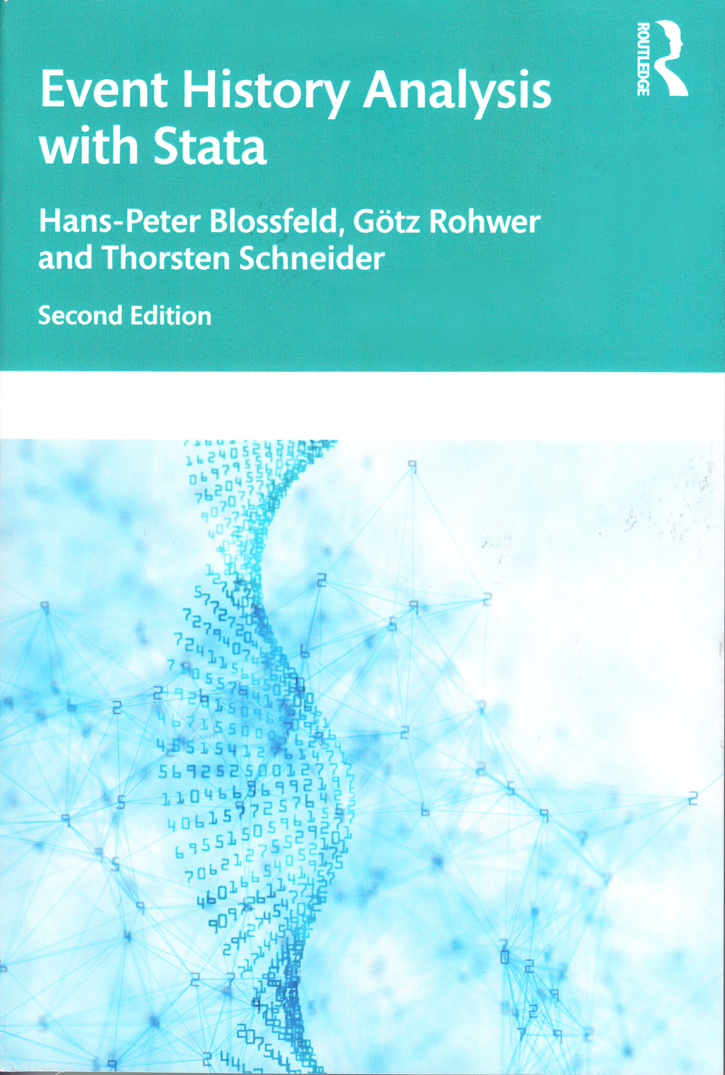

Event History Analysis With Stata, Second Edition |
||||||||||||||||||||||||||||||||||||
 Click to enlarge See the back cover |

As an Amazon Associate, StataCorp earns a small referral credit from
qualifying purchases made from affiliate links on our site.
eBook not available for this title
eBook not available for this title |
|
||||||||||||||||||||||||||||||||||
Comment from the Stata technical groupEvent History Analysis with Stata, by Hans-Peter Blossfeld, Katrin Golsch, and Götz Rohwer, presents survival analysis from a social science perspective. Introducing the mathematics and statistics of survival analysis, along with substantive discussions of social science data issues, the authors give examples throughout using Stata (version 15) and data from the German Life History Study. The text covers both basic and advanced topics, from an introduction to life tables to fitting parametric models with unobserved heterogeneity. The authors aptly illustrate the entire research path required in applying event history analysis, from the initial problems of recording event-oriented data to data organization, software applications, and interpreting results. After a substantive discussion of event history data, the authors explain, throughout the book, the theory and application of nonparametric methods, parametric regression, and finally the Cox model. The chapters on parametric analysis contain an instructive and detailed discussion on time-dependent covariates and practical situations where these might be present. The book provides a link to the authors' site, where readers can find the dataset and the code used in the examples. New in this edition is an Appendix that will allow readers to consolidate the concepts just learned by applying them in practical exercises using data from the German National Educational Panel Study. Event History Analysis with Stata is aimed at the professional social scientist but could also serve as a graduate-level text. |
||||||||||||||||||||||||||||||||||||
Table of contentsView table of contents >> Preface
Acknowledgements
1 Introduction
1.1 Causal modeling and observation plans
1.1.1 Cross-sectional data
1.2 Event history analysis and causal modeling
1.1.2 Panel data 1.1.3 Event history data
1.2.1 Causal explanations
1.2.2 Transition rate models
2 Event history data structures
2.1 Basic terminology
2.2 Event history data organization
2.2.1 Using event history data files with Stata
2.2.2 Executing Stata with a do-file 2.2.3 Single episode data 2.2.4 Multiepisode data
3 Nonparametric descriptive methods
3.1 Life table method
3.2 Product-limit estimation 3.3 Comparing survivor functions
4 Exponential transition rate models
4.1 The basic exponential model
4.1.1 Maximum likelihood estimation
4.2 Models with Multiple decisions 4.1.2 Models without covariates 4.1.3 Time-constant covariates 4.3 Models with multiple episodes
5 Piecewise constant exponential models
5.1 The basic model
5.2 Models without covariates 5.3 Models with proportional covariate effects 5.4 Models with period-specific effects
6 Exponential models with time-dependent covariates
6.1 Parallel and interdependent processes
6.2 Interdependent processes: the system approach 6.3 Interdependent processes: the causal approach 6.4 Episode splitting with qualitative covariates 6.5 Episode splitting with quantitative covariates 6.6 Application examples
7 Parametric models of time dependence
7.1 Interpretation of time-dependence
7.2 Gompertz models 7.3 Weibull models 7.4 Log-logistic models 7.5 Log-normal models 7.6 Conclusion: Estimating time-dependent models with Stata
8 Methods to check parametric assumptions
8.1 Simple graphic methods
8.2 Pseudoresiduals
9 Semiparametric transition rate models
9.1 Partial likelihood estimation
9.2 Time-dependent covariates 9.3 The proportionality assumption 9.4 Stratification with covariates and for multiepisode data 9.5 Baseline rates and survivor functions 9.6 Application example
10 Problems of model specification
10.1 Unobserved heterogeneity
10.2 Models with a mixture distribution
10.2.1 Models with a gamma mixture
10.3 Discussion
10.2.2 Exponential models with a gamma mixture 10.2.3 Weibull models with a gamma mixture 10.2.4 Random effects for multiepisode data
11 Introduction to sequence analysis by
Brendan Halpin
11.1 Defining distances
11.2 Doing sequence analysis in Stata 11.3 Unary summaries 11.4 Intersequence distance 11.5 What to do with sequence distances? 11.6 Optimal matching distance 11.7 Special topics 11.8 Conclusion
Appendix: exercises
References
About the Authors
Index
|
||||||||||||||||||||||||||||||||||||
Learn
Free webinars
NetCourses
Classroom and web training
Organizational training
Video tutorials
Third-party courses
Web resources
Teaching with Stata
© Copyright 1996–2026 StataCorp LLC. All rights reserved.
×
We use cookies to ensure that we give you the best experience on our website—to enhance site navigation, to analyze usage, and to assist in our marketing efforts. By continuing to use our site, you consent to the storing of cookies on your device and agree to delivery of content, including web fonts and JavaScript, from third party web services.
Cookie Settings
Last updated: 16 November 2022
StataCorp LLC (StataCorp) strives to provide our users with exceptional products and services. To do so, we must collect personal information from you. This information is necessary to conduct business with our existing and potential customers. We collect and use this information only where we may legally do so. This policy explains what personal information we collect, how we use it, and what rights you have to that information.
These cookies are essential for our website to function and do not store any personally identifiable information. These cookies cannot be disabled.
This website uses cookies to provide you with a better user experience. A cookie is a small piece of data our website stores on a site visitor's hard drive and accesses each time you visit so we can improve your access to our site, better understand how you use our site, and serve you content that may be of interest to you. For instance, we store a cookie when you log in to our shopping cart so that we can maintain your shopping cart should you not complete checkout. These cookies do not directly store your personal information, but they do support the ability to uniquely identify your internet browser and device.
Please note: Clearing your browser cookies at any time will undo preferences saved here. The option selected here will apply only to the device you are currently using.